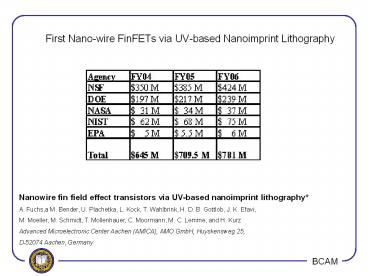First Nano-wire FinFETs via UV-based Nanoimprint Lithography PowerPoint PPT Presentation
1 / 11
Title: First Nano-wire FinFETs via UV-based Nanoimprint Lithography
1
First Nano-wire FinFETs via UV-based Nanoimprint
Lithography
Nanowire fin field effect transistors via
UV-based nanoimprint lithography A. Fuchs,a M.
Bender, U. Plachetka, L. Kock, T. Wahlbrink, H.
D. B. Gottlob, J. K. Efavi, M. Moeller, M.
Schmidt, T. Mollenhauer, C. Moormann, M. C.
Lemme, and H. Kurz Advanced Microelectronic
Center Aachen (AMICA), AMO GmbH, Huyskensweg
25, D-52074 Aachen, Germany
2
Outline
- Nanoimprint
- UV-Nanoimprint
- FinFETs
- Fabrication of FinFETs
- Performance of FinFETs fabricated
3
Introduction to Nanoimprint
Nanoimprint lithography (NIL) Conventional NIL
processes, coined as stamp and step processes
require thermal cycles between 140C and 180C
and high pressures during the hot embossing
procedure. Thermal and mechanical loads involved
in these processes represent a nearly prohibitive
burden for fast and high precision alignment. The
mechanical masses to be moved in high throughput
equipment require a large degree of complex
mechanical handling.
4
Background on UV-Nanoimprint
UV based nanoimprint lithography (UV-NIL) The
low pressure (lt1bar) as well as the absence of
any thermalcycles appears very attractive for
high precision printing down to 10 nm and
relaxes the technical requirements for placement
accuracy and pattern fidelity to a large extent.
5
Wafer level UV-Nanoimprint
- Step Repeat UV Nanoimprint
- A resist is spin coated on the substrate.
- For highest resolution and minimum distortion a
rigid fused silica template is used to imprint
features die by die. The template is pressed into
a thin layer of imprint resist via uniform
pressure of a few hundred millibar. - After alignment of substrate and template in
contact UV light is used to harden the resist. - After detachment the template is moved to the
next position on the wafer and the process is
repeated until the wafer is completely patterned.
6
Introduction on FETs
7
Introduction on FinFETs
8
Process flow of FinFETs via UV-Nanoimprint
5 mm thick 1in mold used with 150nm deep
features. 1. Pattern the S/D and channel
structure a. Imprint process at
reduced ambient pressure 20 mbars and imprint
pressure of 300mbars. b. UV curing
resist---mold detached---RIE etching 2. CVD
polysilicon for gate (heavily doped) 3.
Pattern the gate 4. S/D implantation (As2
x 10E20 ions/cm2)
9
SEM images of FinFETs via Nanoimprint
10
Performance result of FinFETs
Transistor output characteristics exhibits linear
and saturation regions!!! Typical field effect
transistor behavior is clearly observed!!!
Wait.
11
Conclusion
- Promising approach.
- Yield??
Questions???

